No products in the cart.
Gear for Expedition Horseback Riding in Mongolia
The right gear for our expedition horseback riding in Mongolia is something we put a lot of thought into. Most travelers coming to Mongolia to ride with Stone Horse are well prepared for the expeditions we do here. But you don’t want your holiday spoiled by not having the right stuff. You will want to have the right gear for expedition horseback riding in Mongolia. From the moment people contact us and book a trip, we stay in touch with them to advise on the type of clothing and equipment they will need for the particular trip they’re riding on and for the time of year that they’re here. Each year and season is different, and from our first trips in June through the hotter, wetter months of summer and into the colorful crisp days of autumn, the weather and temperatures can vary considerably.
Horse Riding Tour Mongolia Preparation
So, with this in mind, I want to speak in a little more detail to the type of clothing anyone traveling with us should consider when preparing and packing for a trip to Mongolia. Many people will have their own preferred items of clothing and equipment for horseback riding which they already feel comfortable with, and I would encourage you to bring those. Many of the clothing and equipment items suggested are also used by backpackers and trekkers. So it’s likely that travelers already have most of the clothing and equipment needed for a trip with Stone Horse. But, we do provide a suggested clothing and equipment check list which you can find below, and on our website to help cover anything not considered. We’ll update this occasionally too.
Mongolia Horse Trek Packing – Pack and Saddle Horses on the Trail
We stress lightweight and compactable. We supply a 20 liter waterproof bag for clothing and items that you don’t need during the day. These are loaded on the pack horses. We want to keep their loads light. We also supply saddlebags and cantle bags (behind the saddle) for clothing and items you want access to while riding during the day. These are also about 20 to 25 liters in volume. Combined they make up considerable space, about the size of a backpack, but you’ll still want to keep things to the necessary items and lightweight.
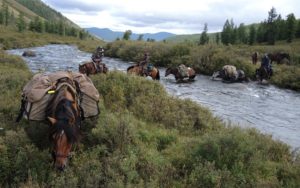
Clothing First for our Horseback Expeditions
Just like earth first, you’ll want to think of clothing first and what will be the most comfortable and durable for a week or more of everyday, all day riding. Good clothing is not only essential to your comfort but to your safety in the back country as well. If you really want to test a piece of clothing or gear, take it on a horse trek. Our boys (horses) are expert at finding the flaws in anything.
Pants before Shoes – Horse Riding Pants
For riding you’ll want either a good pair of riding pants that stretch somewhat, or,what I use, a loose fitting pants like jeans that give a little room for bending, getting on and off the horses and allow a little breathability. On the colder rides early in the season and in the autumn you’ll want something you can fit over long underwear and still feel comfortable.
Here’s an example of riding pants for men and for women. There are many styles and prices to choose from so look for something right for you.
For around camp, a second pair of lightweight pants that you can change into after the ride that you’ll feel comfortable in around the fire will be good to have. You’ll want something comfortable for walking or just hanging out around the food table. Again, these should be somewhat loose fitting to be able to go over long underwear when needed.
Shirts for Horseback Travel
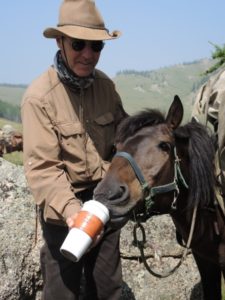
A comfortable loose fitting long sleeve shirt with a pocket or two is what I use. The pockets come in handy. A number of outdoor clothing companies now make these in a wide range of colors, they’re lightweight and pack down very well, wash and dry easily and are UV resistant protecting you from sunlight. Or, a pullover shirt if you prefer that, but again, keep them loose fitting and lightweight. For around camp bring a second or third shirt as well. But try to use something that packs down well to consider space and weight.
Socks
These are important items, as all the clothing is. A good wool blend hiking sock is best. A Smartwool type sock is good and they come in several weights or thicknesses for both men and women. There are a number of different brands. Bring 3 or 4 pair should any get wet with rain or soggy from wet grass, so you’ve got extras for changing. A local outdoor store or backpacking/trekking store would have something to choose from. There are smart socks these days that can turn the heat up for more warmth and even monitor your body functions.
Long underwear for Cool Weather Horseback Riding
For the June trip and late summer and autumn trips, a light set of long underwear, either polypro or wool is nice to have. If you don’t use them in the day, you may use them at night in the sleeping bag. A little heavier set for the late September and October trips should be considered. It will be colder. We’ll advise people going on those trips about that. These can be found at an outdoor clothing store or online.
Sports bra
This is for the ladies and of course it’s only a personal preference but recommended. On horseback riding expeditions like we do, we’ll be spending extended time trotting up and down long river valleys filled with wildflowers or the beautiful colors of autumn. We have it on good authority that a sports bra is a nice clothing item to help make those trots a little more comfortable.
Pile fleece sweater or jacket
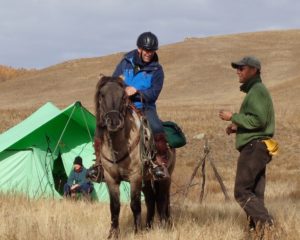
A lot of outdoor wear companies make these in many colors, styles, with or without hoods, etc. It’s your personal preference, but they are nice for chilly mornings and evenings around camp and under the wind/rain proof jacket or coat when it turns a little cold. They’re also quite durable and easily cleaned. They can be found online, in outdoor or trekking and backpacking stores in most places.
Neckerchief or neck gaiter
This is a personal preference item, but does make a difference if we’re riding for hours into a cool wind. They too can be found in outdoor wear shops. They’re lightweight and stuff in a pocket easily for use and storage. These can be used in a variety of ways and come in different colors and patterns for men and the ladies.
Light down or synthetic fill jacket
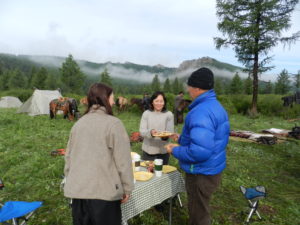
The lightweight down or synthetic jacket is definitely needed from late August through October. There a number of different makes/models. They can be a bit pricey so look for a good deal before coming on a trip if you don’t have something like this already. There’s a great lightweight jacket by Columbia Sportswear Company with the new “thermal comfort Omni-Heat” silver lining that reflects body heat back in to the wearer. It’s all synthetic and easily washed. Here’s a men’s and women’s model. Combined with the polypro jacket, long underwear and rain/wind proofs, it will keep you toasty. Other companies may now make similar items, so look around. Again, we can advise on these things if you have questions.
Must Have Equipment for Mongolia Horse Riding
Outer wind/rain proof parka and pants
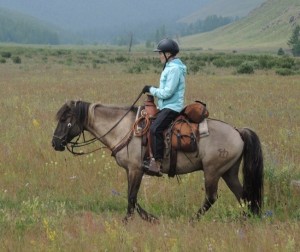
This is a MUST HAVE item. Let me stress that again, this is a MUST HAVE item. A good set of wind/rain proof gear (jacket and pants) makes all the difference in keeping warm and dry in wind and rain and can save your life. Combined with a polypro or light down jacket, it’s easy to weather fairly cool temperatures. You’ll want something that is somewhat loose and easily fits over your clothing. Look for pants with zippers that come at least half way up the outer leg. This will make it easier to put them on over shoes or boots. The jacket should also have a hood to keep rain off your neck and keep in warmth.
A wind/rain suit comes in a variety of styles, colors and costs. Look for something lightweight yet fairly durable. If you already have a wind/rain suit for trekking or backpacking, this will be perfect. Just make sure it really is rain proof. Put it on in the shower. Check out your nearby outdoor store to see what they may have, or look online for examples of what is available. Here are a couple of examples of men’s rain pants and a rain jacket and women’s.
Hats – polypro/wool cap, sun hat
A good wide brimmed hat or cap to keep the sun off you on rides during the hotter months is important. You’ll want something you can pack away and that will resume its shape again when taken out of a saddlebag or pocket. They come in both men’s and women’s styles and the links here will give you an idea of the type of packable hats available. Your nearby outdoor shops may also have something you like and at a good price.
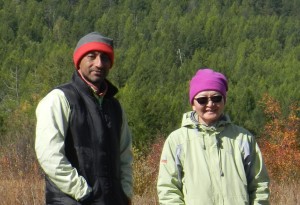
A good wool or polypro beanie (hat) is also important to have for chilly mornings and evenings. Something you can just pull over quickly to keep head and ears warm. These are good to wear under your riding helmet on colder days. They’re also good for sleeping on colder nights. They come in a variety of colors and shapes. My mother used to knit strange colored weird ones for me all the time. She was ahead of her time. The website link above will show examples of what we mean. You can probably find these in most local outdoor shops or clothing stores for fairly inexpensive prices.
Gloves – for riding and chilly days
A lightweight pair of leather or synthetic leather gloves can be good to both protect your hands from sun and holding a set of leather reins all day. If you’re not used to riding, the chafing of reins can cause a blister or two. There are some pretty stylish garden gloves nowadays that are inexpensive and will do the trick as well. The link above is to some examples of pretty cool ones.
For colder mornings and evenings, a lightweight pair of polypro gloves are nice to have in your kit. Polypro gloves are good because they keep your hands warm even when wet and they dry out fast.
For the autumn rides a pair of gloves with some insulation will be needed. A shell for over your polypro or wool gloves or an inexpensive pair of ski gloves works really well. They have some synthetic pile insulation, are windproof, lightweight, usually a bit water resistant and provide good warmth.
Shoes/boots
With riding shoes and boots, you’ll want to use something that is comfortable for both riding and walking. Something that is a bit waterproof and lightweight. A good pair of walking boots will do just fine. Endurance riders use something like this to accommodate both riding and walking on their 100 mile rides. Combined with a set of leather or synthetic half chaps (gaiters) for riding, they work really well for our type of trips. All our saddles are fitted with stirrup cages to keep your foot from slipping through, so a shoe with a pronounced heal is not necessary. It’s important that they are fairly well broken in and not brand new. The main thing is to wear what is comfortable for you, that is within your budget, and won’t give you trouble on the trip. There are a lot of models and brands out there.
Here are a couple of inexpensive examples for men and for women. Or a more pricey set for men and women.
On the autumn trips, it’s important to have a walking/riding shoe that will also fit when you have slightly thicker socks on.
A lightweight pair of shoes for around camp are also useful if you want to kick off your riding boots after the day’s ride. This depends on if you want to carry them, but running shoes are ideal for this and can compact down well.
Riding Helmet
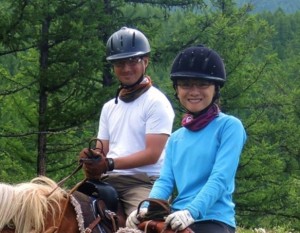
If you have a riding helmet that you’re comfortable with, and that can fit a wool or polypro beanie underneath for chilly days, bring that. Many of our guests prefer to use their own helmets. If you don’t have one or don’t want to lug it halfway around the world, we have simple adjustable helmets that can accommodate you. But you might like the way you look in your own helmet. Got to think about those photo’s to show back home.
Half chaps
Half chaps are leather or synthetic gaiters that fit around your shoe or boot to provide leg and calf protection up to your knee. These help prevent chafing of the calf area when riding for long periods and keep your pants a bit dryer and clean from mud and debris. Again, many of our guests have their own and prefer to bring them. If you buy a pair, make sure they fit over your preferred riding pants and shoes/boots. You don’t want them too tight. We can supply our guests with half chaps if they don’t have any.
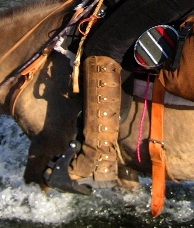
Other gear for expedition horseback riding in Mongolia
Head lamp
A head lamp is really good to have on these kinds of trips. With a head lamp both your hands are free to use for any task necessary during the night time hours. These days head lamps are cheap and lightweight and only take 2 or 3 AAA batteries. They can be found in large outdoor shops, online or your local backpacking store. The web link above gives you a good idea of the type of headlamps that are around.
Binoculars
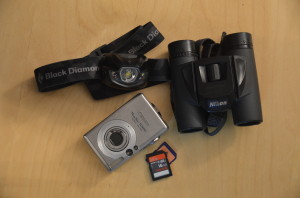
These are not a necessary item, but they are useful for getting a closer look at birds or other wildlife and some people do like to bring them. A small lightweight folding pair is best for horseback riding. Nikon, Bushnell and Brunton are a few brands that make decent compact binoculars at reasonable prices. We carry a couple of pairs anyhow. You’ll want to make sure you have a compact padded case for them to keep them safe in your saddlebag.
Camera and batteries
The camera to bring is up to you, but remember, we’ll be trotting along on a horse each day. A small easy to use point and shoot camera with vibration reduction is best while riding. They easily fit in a pocket or padded belt case for ease of access and storage and they don’t cost a lot. For a week of riding you’ll want 2 or 3 extra batteries. If you take a lot of photos, you’ll want at least 4 batteries and an extra card. There are so many good ones out there these days to choose from it’s difficult to recommend any one brand over another. Nikon, Sony, Canon, Konica, and others all have models that are good. You’ll want something that takes good photos though. The scenery is spectacular. And, as with binoculars, you’ll want make sure you have some sort of padded case to carry it in when not in use.
Digital SLR’s
Larger camera’s like digital SLR’s with interchangeable lenses are great for really good photos. I love to use my Nikon DSLR. You can carry these while riding, but bear in mind they can be cumbersome and vulnerable. I would encourage anyone who has larger cameras to bring them. They can be stored in the saddlebags and easily accessed when you want. A compact padded camera bag and or lens bag will be necessary for their protection. You’ll want several extra batteries for these as well.
Personal toiletries
For your personal items you want a small kit bag like you’d use for any travel. Something that won’t fall apart is best. A mesh bag that you can see into is good for getting at items you need quickly. There are lots of choices out there and inexpensive.
First aid kit
We carry comprehensive first aid kits with us at all times. However, you may want to consider adding a few band aids, alcohol wipes and some antiseptic/antibiotic cream to your toiletry kit or even a mini first aid pouch. Always good to have when traveling.
Chafing Cream/Powder
If you haven’t ridden in awhile and are susceptible to chafing, some of our previous guests have suggested that you may want to bring a small tube of chafing cream or powder to put on before we start to sooth those tender areas that meet the saddle. This can be found at most bicycle shops as well or ordered online. You may only need it once or twice, but it’s well worth it. There are a variety of brands out there, but the links here offer one for the men and one for the ladies.
Sun block
Sun block is really essential when traveling during the mid summer months, in fact any time during the season. We’re exposed to the sun all day long. Get the strongest grade of sun block you can buy. If possible get sun block that comes in a tube with a screw on cap for ease of transport during the ride.
Insect repellent
We do have biting insects like horse and deer flies and Mosquito’s along the way, especially during the July and early August trips. They disappear after sundown, but it is recommended that you bring a good insect repellent to help ward them off during the day as we ride. These come in creams or as sprays. Both are good.
Any questions or suggestions about the equipment?
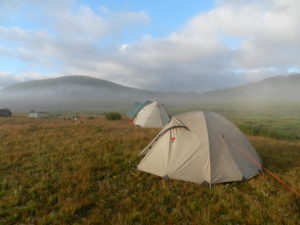
We welcome any questions or comments about the clothing and equipment you need for riding with us. And, if you’ve got a good suggestion we’d love to hear it. Links to the items above are only suggestions and examples of what’s out there. If there is any item you don’t have, can’t find or bring, let us know and we’ll advise you on that. We want to ensure that our guests for these rides have the essentials needed to make you safe and comfortable, so you can concentrate on your horse, the beautiful scenery we ride through, the people we meet and the new and exciting culture you’re experiencing.
Join us on a horse trek this year – A real horse riding adventure!
Check out our 10 Day Gorkhi-Terelj National Park Expedition and our 14 Day Khentii Mountains Expedition and the dates that are still available and book a trip today. We’d love to see you on a ride with us.
Print out the check list below to help sort out what you pack and carry on our horseback riding expedition.
Stone Horse Expeditions & Travel
Clothing and Gear Check List
- Sun hat (either a wide brimmed hat or baseball type cap)
- Lightweight warm hat/beanie (for colder nights and mornings around camp)
- Lightweight gloves (wool or polypro)
- Leather gloves for riding (lightweight work or gardening gloves also work well)
- Lightweight polypro thermal tops/bottoms (autumn trips)
- Polypro sweater or jacket (for cooler nights)
- Light down jacket/sweater with stuff sack (for September/October trips)
- Wind/rain proof tops/bottoms (a MUST have item)**
- Comfortable loose or stretch pants for riding
- Comfortable loose shirt (with pockets) for riding
- Lightweight pants for around camp
- Extra shirt for around camp
- Comfortable riding boots or lightweight hiking boots
- 3 pair wool or polypro socks
- Leather or synthetic half chaps (if you have your own)
- Lightweight walking shoes or sandals for around camp
- Riding helmet (if you like your own)
- Bandana or neck gaiter (good for extra sun protection)
- Camera with extra batteries and card
- Personal first aid kit and medications
- Insect repellent (for June/July/August trips)
- Chafing cream or powder (found in bicycle shops)
- Sun block
- Basic Personal toiletries
- Sunglasses
- Small binoculars (optional)
- Small torch/flashlight or headlamp


